前言
在 Redis 3.0 之前,使用 哨兵(sentinel)机制来监控各个节点之间的状态。Redis Cluster 是 Redis 的 分布式解决方案,在 3.0 版本正式推出,有效地解决了 Redis 在 分布式 方面的需求。当遇到 单机内存、并发、流量 等瓶颈时,可以采用 Cluster 架构方案达到 负载均衡 的目的。

本文将从 集群方案、数据分布、搭建集群、节点通信、集群伸缩、请求路由、故障转移、集群运维 等几个方面介绍 Redis Cluster。
正文
1. Redis集群方案
Redis Cluster 集群模式通常具有 高可用、可扩展性、分布式、容错 等特性。Redis 分布式方案一般有两种:
1.1 客户端分区方案
客户端 就已经决定数据会被 存储 到哪个 redis 节点或者从哪个 redis 节点 读取数据。其主要思想是采用 哈希算法 将 Redis 数据的 key 进行散列,通过 hash 函数,特定的 key会 映射 到特定的 Redis 节点上。
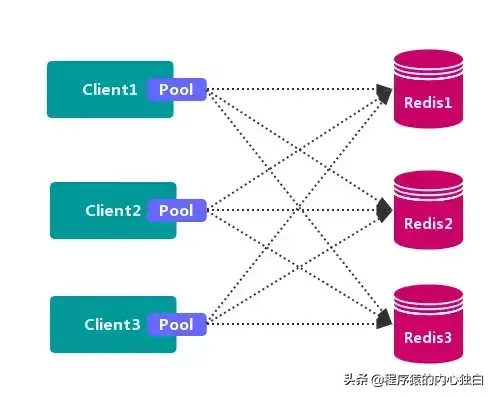
客户端分区方案 的代表为 Redis Sharding,Redis Sharding 是 Redis Cluster 出来之前,业界普遍使用的 Redis 多实例集群 方法。Java 的 Redis 客户端驱动库 Jedis,支持 Redis Sharding 功能,即 ShardedJedis 以及 结合缓存池 的 ShardedJedisPool。
- 优点
不使用 第三方中间件,分区逻辑 可控,配置 简单,节点之间无关联,容易 线性扩展,灵活性强。
- 缺点
客户端 无法 动态增删 服务节点,客户端需要自行维护 分发逻辑,客户端之间 无连接共享,会造成 连接浪费。
1.2. 代理分区方案
客户端 发送请求到一个 代理组件,代理 解析 客户端 的数据,并将请求转发至正确的节点,最后将结果回复给客户端。
- 优点:简化 客户端 的分布式逻辑,客户端 透明接入,切换成本低,代理的 转发 和 存储 分离。
- 缺点:多了一层 代理层,加重了 架构部署复杂度 和 性能损耗。

代理分区 主流实现的有方案有 Twemproxy 和 Codis。
1.2.1. Twemproxy
Twemproxy 也叫 nutcraker,是 twitter 开源的一个 redis 和 memcache 的 中间代理服务器 程序。Twemproxy 作为 代理,可接受来自多个程序的访问,按照 路由规则,转发给后台的各个 Redis 服务器,再原路返回。Twemproxy 存在 单点故障 问题,需要结合 Lvs 和 Keepalived 做 高可用方案。
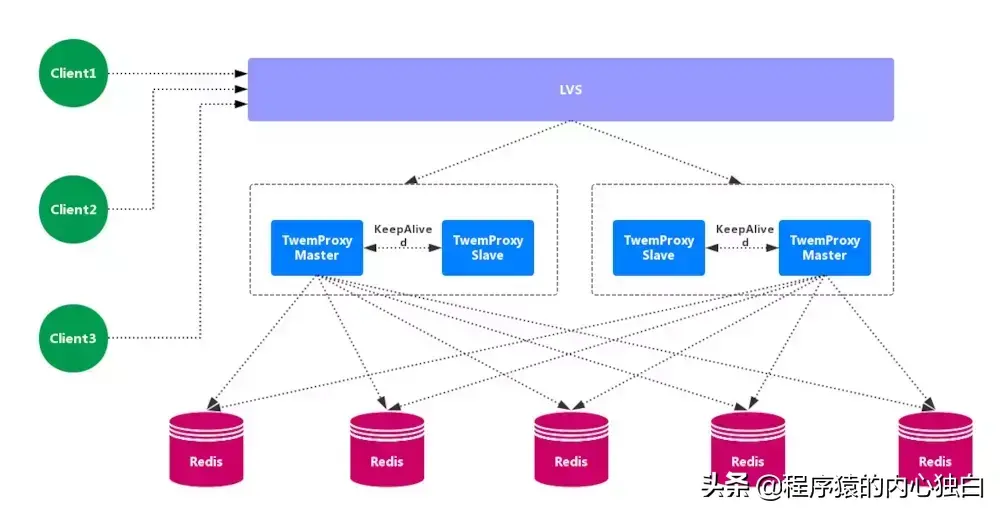
- 优点:应用范围广,稳定性较高,中间代理层 高可用。
- 缺点:无法平滑地 水平扩容/缩容,无 可视化管理界面,运维不友好,出现故障,不能 自动转移。
1.2.2. Codis
Codis 是一个 分布式 Redis 解决方案,对于上层应用来说,连接 Codis-Proxy 和直接连接 原生的 Redis-Server 没有的区别。Codis 底层会 处理请求的转发,不停机的进行 数据迁移 等工作。Codis 采用了无状态的 代理层,对于 客户端 来说,一切都是透明的。
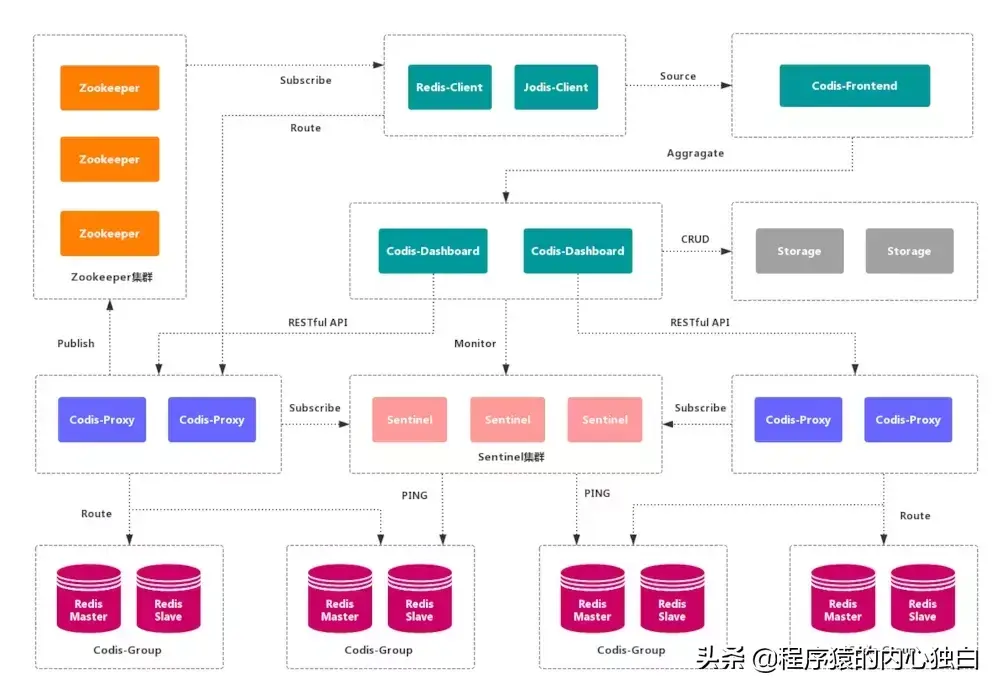
- 优点
实现了上层 Proxy 和底层 Redis 的 高可用,数据分片 和 自动平衡,提供 命令行接口 和 RESTful API,提供 监控 和 管理 界面,可以动态 添加 和 删除 Redis 节点。
- 缺点
部署架构 和 配置 复杂,不支持 跨机房 和 多租户,不支持 鉴权管理。
1.3. 查询路由方案
客户端随机地 请求任意一个 Redis 实例,然后由 Redis 将请求 转发 给 正确 的 Redis 节点。Redis Cluster 实现了一种 混合形式 的 查询路由,但并不是 直接 将请求从一个 Redis 节点 转发 到另一个 Redis 节点,而是在 客户端 的帮助下直接 重定向( redirected)到正确的 Redis 节点。
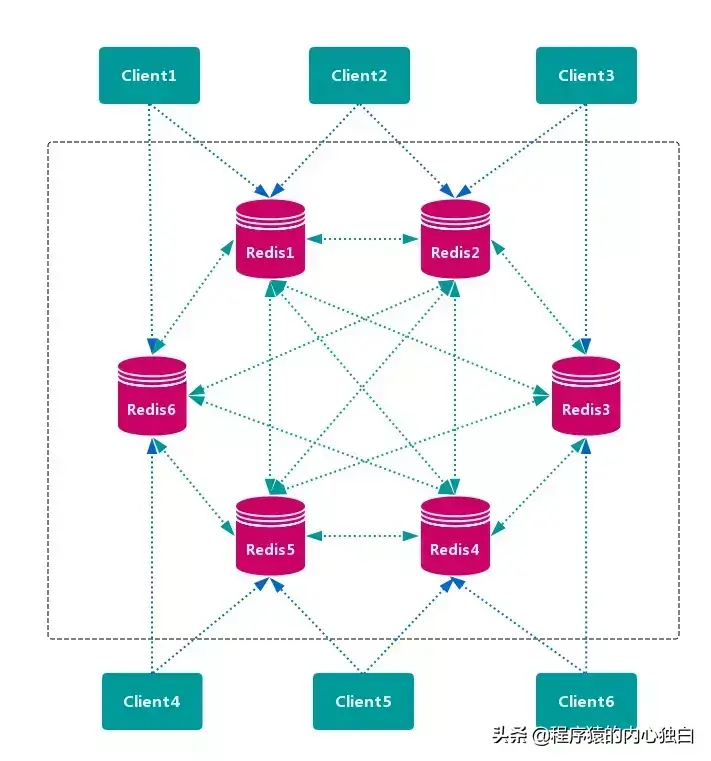
- 优点
无中心节点,数据按照 槽 存储分布在多个 Redis 实例上,可以平滑的进行节点 扩容/缩容,支持 高可用 和 自动故障转移,运维成本低。
- 缺点
严重依赖 Redis-trib 工具,缺乏 监控管理,需要依赖 Smart Client (维护连接,缓存路由表,MultiOp 和 Pipeline 支持)。Failover 节点的 检测过慢,不如 中心节点 ZooKeeper 及时。Gossip 消息具有一定开销。无法根据统计区分 冷热数据。
2. 数据分布
2.1. 数据分布理论
分布式数据库 首先要解决把 整个数据集 按照 分区规则 映射到 多个节点 的问题,即把 数据集 划分到 多个节点 上,每个节点负责 整体数据 的一个 子集。
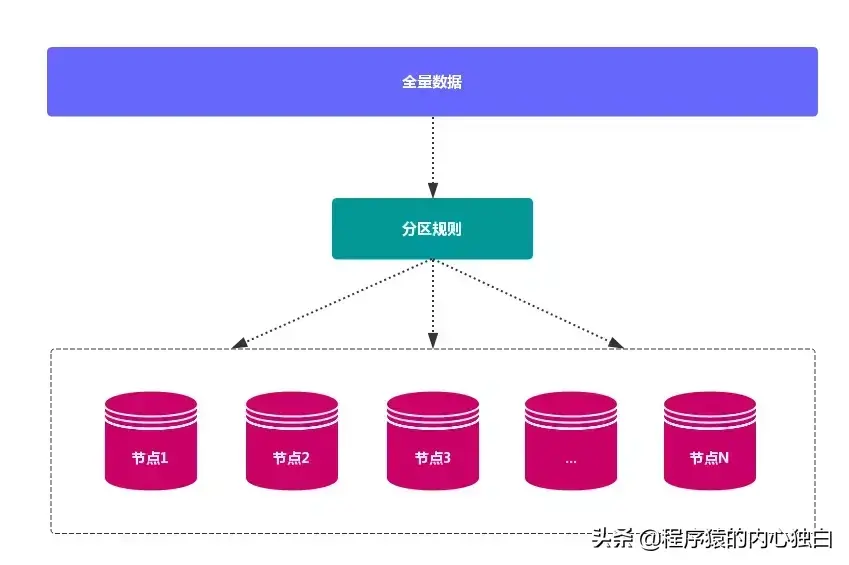
数据分布通常有 哈希分区 和 顺序分区 两种方式,对比如下:

由于 Redis Cluster 采用 哈希分区规则,这里重点讨论 哈希分区。常见的 哈希分区 规则有几种,下面分别介绍:
2.1.1. 节点取余分区
使用特定的数据,如 Redis 的 键 或 用户 ID,再根据 节点数量 N 使用公式:hash(key)% N 计算出 哈希值,用来决定数据 映射 到哪一个节点上。
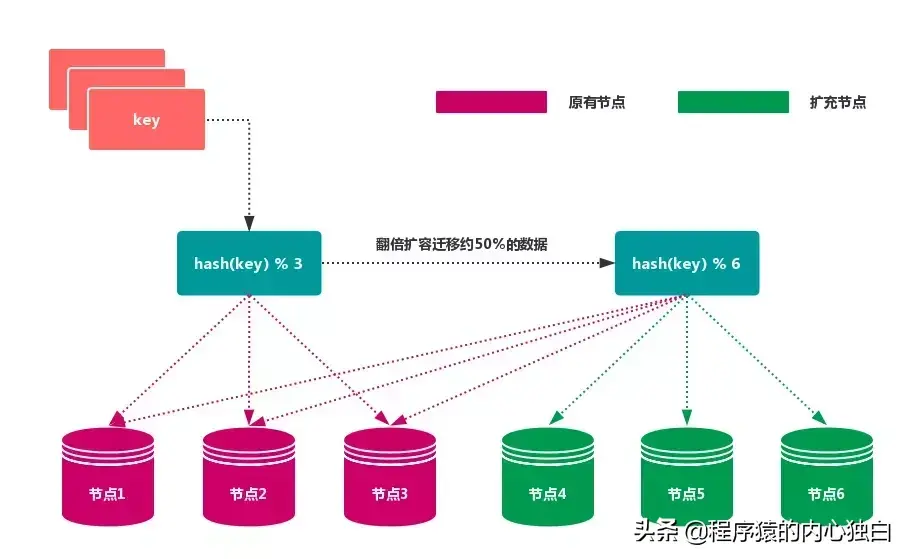
image
- 优点
这种方式的突出优点是 简单性,常用于 数据库 的 分库分表规则。一般采用 预分区 的方式,提前根据 数据量 规划好 分区数,比如划分为 512 或 1024 张表,保证可支撑未来一段时间的 数据容量,再根据 负载情况 将 表 迁移到其他 数据库 中。扩容时通常采用 翻倍扩容,避免 数据映射 全部被 打乱,导致 全量迁移 的情况。
- 缺点
当 节点数量 变化时,如 扩容 或 收缩 节点,数据节点 映射关系 需要重新计算,会导致数据的 重新迁移。
2.1.2. 一致性哈希分区
一致性哈希 可以很好的解决 稳定性问题,可以将所有的 存储节点 排列在 收尾相接 的 Hash 环上,每个 key 在计算 Hash 后会 顺时针 找到 临接 的 存储节点 存放。而当有节点 加入 或 退出 时,仅影响该节点在 Hash 环上 顺时针相邻 的 后续节点。
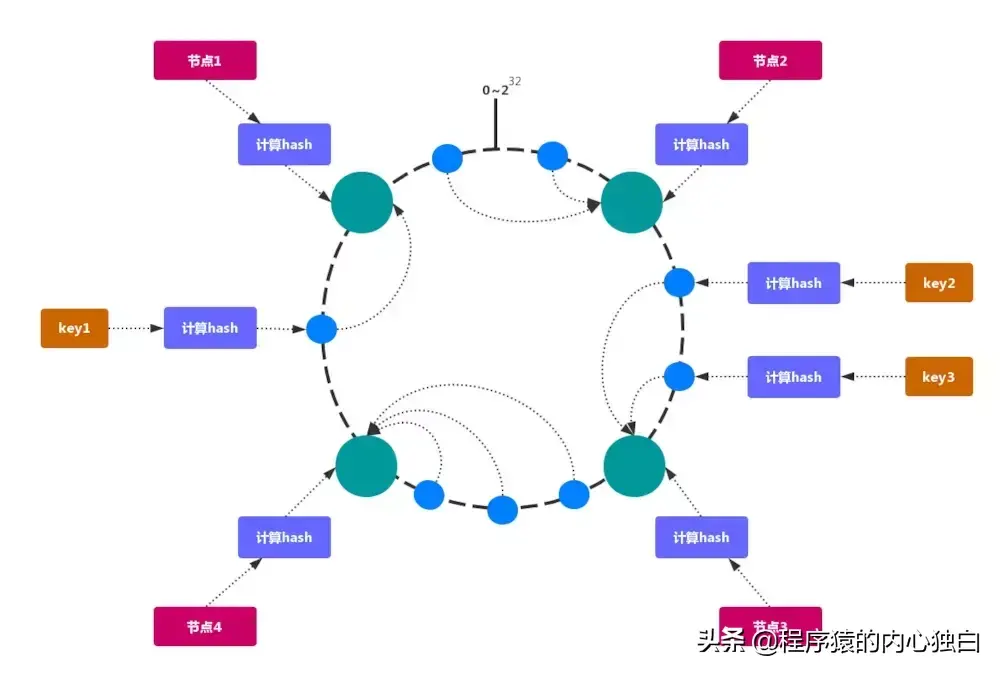
image
- 优点
加入 和 删除 节点只影响 哈希环 中 顺时针方向 的 相邻的节点,对其他节点无影响。
- 缺点
加减节点 会造成 哈希环 中部分数据 无法命中。当使用 少量节点 时,节点变化 将大范围影响 哈希环 中 数据映射,不适合 少量数据节点 的分布式方案。普通 的 一致性哈希分区 在增减节点时需要 增加一倍 或 减去一半 节点才能保证 数据 和 负载的均衡。
注意:因为 一致性哈希分区 的这些缺点,一些分布式系统采用 虚拟槽 对 一致性哈希 进行改进,比如 Dynamo 系统。
2.1.3. 虚拟槽分区
虚拟槽分区 巧妙地使用了 哈希空间,使用 分散度良好 的 哈希函数 把所有数据 映射 到一个 固定范围 的 整数集合 中,整数定义为 槽(slot)。这个范围一般 远远大于 节点数,比如 Redis Cluster 槽范围是 0 ~ 16383。槽 是集群内 数据管理 和 迁移 的 基本单位。采用 大范围槽 的主要目的是为了方便 数据拆分 和 集群扩展。每个节点会负责 一定数量的槽,如图所示:
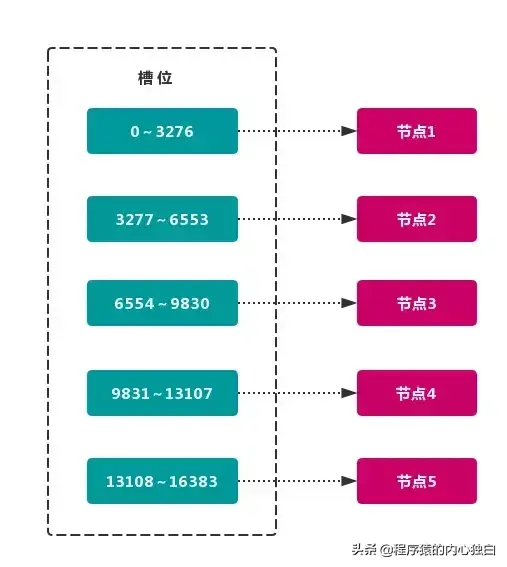
当前集群有 5 个节点,每个节点平均大约负责 3276 个 槽。由于采用 高质量 的 哈希算法,每个槽所映射的数据通常比较 均匀,将数据平均划分到 5 个节点进行 数据分区。Redis Cluster 就是采用 虚拟槽分区。
- 节点1: 包含 0 到 3276 号哈希槽。
- 节点2:包含 3277 到 6553 号哈希槽。
- 节点3:包含 6554 到 9830 号哈希槽。
- 节点4:包含 9831 到 13107 号哈希槽。
- 节点5:包含 13108 到 16383 号哈希槽。
这种结构很容易 添加 或者 删除 节点。如果 增加 一个节点 6,就需要从节点 1 ~ 5 获得部分 槽 分配到节点 6 上。如果想 移除 节点 1,需要将节点 1 中的 槽 移到节点 2 ~ 5 上,然后将 没有任何槽 的节点 1 从集群中 移除 即可。
由于从一个节点将 哈希槽 移动到另一个节点并不会 停止服务,所以无论 添加删除 或者 改变 某个节点的 哈希槽的数量 都不会造成 集群不可用 的状态.
2.2. Redis的数据分区
Redis Cluster 采用 虚拟槽分区,所有的 键 根据 哈希函数 映射到 0~16383 整数槽内,计算公式:slot = CRC16(key)& 16383。每个节点负责维护一部分槽以及槽所映射的 键值数据,如图所示:
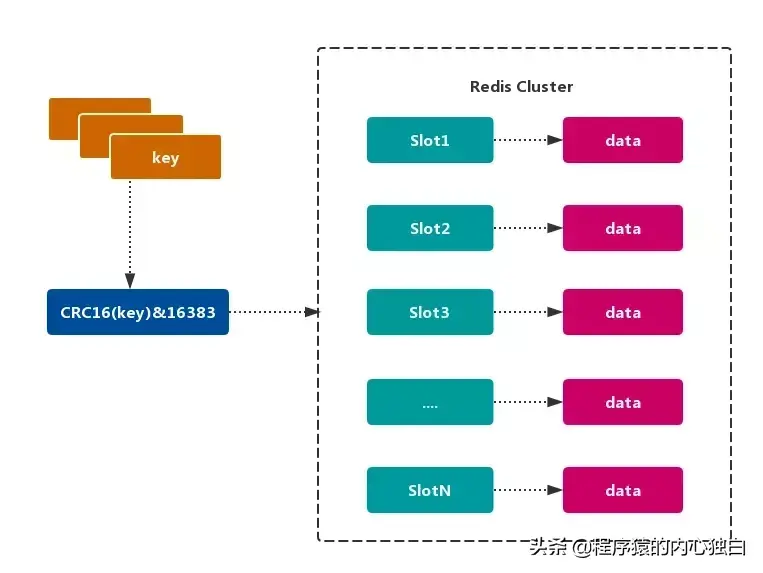
2.2.1. Redis虚拟槽分区的特点
- 解耦 数据 和 节点 之间的关系,简化了节点 扩容 和 收缩 难度。
- 节点自身 维护槽的 映射关系,不需要 客户端 或者 代理服务 维护 槽分区元数据。
- 支持 节点、槽、键 之间的 映射查询,用于 数据路由、在线伸缩 等场景。
2.3. Redis集群的功能限制
Redis 集群相对 单机 在功能上存在一些限制,需要 开发人员 提前了解,在使用时做好规避。
- key 批量操作 支持有限。
类似 mset、mget 操作,目前只支持对具有相同 slot 值的 key 执行 批量操作。对于 映射为不同 slot 值的 key 由于执行 mget、mget 等操作可能存在于多个节点上,因此不被支持。
- key 事务操作 支持有限。
只支持 多 key 在 同一节点上 的 事务操作,当多个 key 分布在 不同 的节点上时 无法 使用事务功能。
- key 作为 数据分区 的最小粒度
不能将一个 大的键值 对象如 hash、list 等映射到 不同的节点。
- 不支持 多数据库空间
单机 下的 Redis 可以支持 16 个数据库(db0 ~ db15),集群模式 下只能使用 一个 数据库空间,即 db0。
- 复制结构 只支持一层
从节点 只能复制 主节点,不支持 嵌套树状复制 结构。
3. Redis集群搭建
Redis-Cluster 是 Redis 官方的一个 高可用 解决方案,Cluster 中的 Redis 共有 2^14(16384) 个 slot 槽。创建 Cluster 后,槽 会 平均分配 到每个 Redis 节点上。
下面介绍一下本机启动 6 个 Redis 的 集群服务,并使用 redis-trib.rb 创建 3主3从 的 集群。搭建集群工作需要以下三个步骤:
3.1. 准备节点
Redis 集群一般由 多个节点 组成,节点数量至少为 6 个,才能保证组成 完整高可用 的集群。每个节点需要 开启配置 cluster-enabled yes,让 Redis 运行在 集群模式 下。
Redis 集群的节点规划如下:
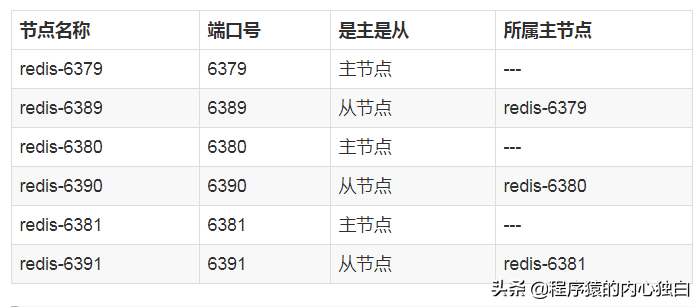
注意:建议为集群内 所有节点 统一目录,一般划分三个目录:conf、data、log,分别存放 配置、数据 和 日志 相关文件。把 6 个节点配置统一放在 conf 目录下。
3.1.1. 创建redis各实例目录
$ sudo mkdir -p /usr/local/redis-cluster
$ cd /usr/local/redis-cluster
$ sudo mkdir conf data log
$ sudo mkdir -p data/redis-6379 data/redis-6389 data/redis-6380 data/redis-6390 data/redis-6381 data/redis-6391
3.1.2. redis配置文件管理
根据以下 模板 配置各个实例的 redis.conf,以下只是搭建集群需要的 基本配置,可能需要根据实际情况做修改。
# redis后台运行
daemonize yes
# 绑定的主机端口
bind 127.0.0.1
# 数据存放目录
dir /usr/local/redis-cluster/data/redis-6379
# 进程文件
pidfile /var/run/redis-cluster/${自定义}.pid
# 日志文件
logfile
/usr/local/redis-cluster/log/${自定义}.log
# 端口号
port 6379
# 开启集群模式,把注释#去掉
cluster-enabled yes
# 集群的配置,配置文件首次启动自动生成
cluster-config-file
/usr/local/redis-cluster/conf/${自定义}.conf
# 请求超时,设置10秒
cluster-node-timeout 10000
# aof日志开启,有需要就开启,它会每次写操作都记录一条日志
appendonly yes
- redis-6379.conf
daemonize yes
bind 127.0.0.1
dir /usr/local/redis-cluster/data/redis-6379
pidfile /var/run/redis-cluster/redis-6379.pid
logfile /usr/local/redis-cluster/log/redis-6379.log
port 6379
cluster-enabled yes
cluster-config-file /usr/local/redis-cluster/conf/node-6379.conf
cluster-node-timeout 10000
appendonly yes
- redis-6389.conf
daemonize yes
bind 127.0.0.1
dir /usr/local/redis-cluster/data/redis-6389
pidfile /var/run/redis-cluster/redis-6389.pid
logfile /usr/local/redis-cluster/log/redis-6389.log
port 6389
cluster-enabled yes
cluster-config-file /usr/local/redis-cluster/conf/node-6389.conf
cluster-node-timeout 10000
appendonly yes
- redis-6380.conf
daemonize yes
bind 127.0.0.1
dir /usr/local/redis-cluster/data/redis-6380
pidfile /var/run/redis-cluster/redis-6380.pid
logfile /usr/local/redis-cluster/log/redis-6380.log
port 6380
cluster-enabled yes
cluster-config-file /usr/local/redis-cluster/conf/node-6380.conf
cluster-node-timeout 10000
appendonly yes
- redis-6390.conf
daemonize yes
bind 127.0.0.1
dir /usr/local/redis-cluster/data/redis-6390
pidfile /var/run/redis-cluster/redis-6390.pid
logfile /usr/local/redis-cluster/log/redis-6390.log
port 6390
cluster-enabled yes
cluster-config-file /usr/local/redis-cluster/conf/node-6390.conf
cluster-node-timeout 10000
appendonly yes
- redis-6381.conf
daemonize yes
bind 127.0.0.1
dir /usr/local/redis-cluster/data/redis-6381
pidfile /var/run/redis-cluster/redis-6381.pid
logfile /usr/local/redis-cluster/log/redis-6381.log
port 6381
cluster-enabled yes
cluster-config-file /usr/local/redis-cluster/conf/node-6381.conf
cluster-node-timeout 10000
appendonly yes
- redis-6391.conf
daemonize yes
bind 127.0.0.1
dir /usr/local/redis-cluster/data/redis-6391
pidfile /var/run/redis-cluster/redis-6391.pid
logfile /usr/local/redis-cluster/log/redis-6391.log
port 6391
cluster-enabled yes
cluster-config-file /usr/local/redis-cluster/conf/node-6391.conf
cluster-node-timeout 10000
appendonly yes
3.2. 环境准备
3.2.1. 安装Ruby环境
$ sudo brew install ruby
3.2.2. 准备rubygem redis依赖
$ sudo gem install redis
Password:
Fetching: redis-4.0.2.gem (100%)
Successfully installed redis-4.0.2
Parsing documentation for redis-4.0.2
Installing ri documentation for redis-4.0.2
Done installing documentation for redis after 1 seconds
1 gem installed
3.2.3. 拷贝redis-trib.rb到集群根目录
redis-trib.rb 是 redis 官方推出的管理 redis 集群 的工具,集成在 redis 的源码 src 目录下,将基于 redis 提供的 集群命令 封装成 简单、便捷、实用 的 操作工具。
$ sudo cp /usr/local/redis-4.0.11/src/redis-trib.rb /usr/local/redis-cluster
查看 redis-trib.rb 命令环境是否正确,输出如下:
$ ./redis-trib.rb
Usage: redis-trib <command> <options> <arguments ...>
create host1:port1 ... hostN:portN
--replicas <arg>
check host:port
info host:port
fix host:port
--timeout <arg>
reshard host:port
--from <arg>
--to <arg>
--slots <arg>
--yes
--timeout <arg>
--pipeline <arg>
rebalance host:port
--weight <arg>
--auto-weights
--use-empty-masters
--timeout <arg>
--simulate
--pipeline <arg>
--threshold <arg>
add-node new_host:new_port existing_host:existing_port
--slave
--master-id <arg>
del-node host:port node_id
set-timeout host:port milliseconds
call host:port command arg arg .. arg
import host:port
--from <arg>
--copy
--replace
help (show this help)
For check, fix, reshard, del-node, set-timeout you can specify the host and port of any working node in the cluster.
redis-trib.rb 是 redis 作者用 ruby 完成的。redis-trib.rb 命令行工具 的具体功能如下:

3.3. 安装集群
3.3.1. 启动redis服务节点
运行如下命令启动 6 台 redis 节点:
sudo redis-server conf/redis-6379.conf
sudo redis-server conf/redis-6389.conf
sudo redis-server conf/redis-6380.conf
sudo redis-server conf/redis-6390.conf
sudo redis-server conf/redis-6381.conf
sudo redis-server conf/redis-6391.conf
启动完成后,redis 以集群模式启动,查看各个 redis 节点的进程状态:
$ ps -ef | grep redis-server
0 1908 1 0 4:59下午 ?? 0:00.01 redis-server *:6379 [cluster]
0 1911 1 0 4:59下午 ?? 0:00.01 redis-server *:6389 [cluster]
0 1914 1 0 4:59下午 ?? 0:00.01 redis-server *:6380 [cluster]
0 1917 1 0 4:59下午 ?? 0:00.01 redis-server *:6390 [cluster]
0 1920 1 0 4:59下午 ?? 0:00.01 redis-server *:6381 [cluster]
0 1923 1 0 4:59下午 ?? 0:00.01 redis-server *:6391 [cluster]
在每个 redis 节点的 redis.conf 文件中,我们都配置了 cluster-config-file 的文件路径,集群启动时,conf 目录会新生成 集群 节点配置文件。查看文件列表如下:
$ tree -L 3 .
.
├── appendonly.aof
├── conf
│ ├── node-6379.conf
│ ├── node-6380.conf
│ ├── node-6381.conf
│ ├── node-6389.conf
│ ├── node-6390.conf
│ ├── node-6391.conf
│ ├── redis-6379.conf
│ ├── redis-6380.conf
│ ├── redis-6381.conf
│ ├── redis-6389.conf
│ ├── redis-6390.conf
│ └── redis-6391.conf
├── data
│ ├── redis-6379
│ ├── redis-6380
│ ├── redis-6381
│ ├── redis-6389
│ ├── redis-6390
│ └── redis-6391
├── log
│ ├── redis-6379.log
│ ├── redis-6380.log
│ ├── redis-6381.log
│ ├── redis-6389.log
│ ├── redis-6390.log
│ └── redis-6391.log
└── redis-trib.rb
9 directories, 20 files
3.3.2. redis-trib关联集群节点
按照 从主到从 的方式 从左到右 依次排列 6 个 redis 节点。
$ sudo ./redis-trib.rb create --replicas 1 127.0.0.1:6379 127.0.0.1:6380 127.0.0.1:6381 127.0.0.1:6389 127.0.0.1:6390 127.0.0.1:6391
集群创建后,redis-trib 会先将 16384 个 哈希槽 分配到 3 个 主节点,即 redis-6379,redis-6380 和 redis-6381。然后将各个 从节点 指向 主节点,进行 数据同步。
>>> Creating cluster
>>> Performing hash slots allocation on 6 nodes...
Using 3 masters:
127.0.0.1:6379
127.0.0.1:6380
127.0.0.1:6381
Adding replica 127.0.0.1:6390 to 127.0.0.1:6379
Adding replica 127.0.0.1:6391 to 127.0.0.1:6380
Adding replica 127.0.0.1:6389 to 127.0.0.1:6381
>>> Trying to optimize slaves allocation for anti-affinity
[WARNING] Some slaves are in the same host as their master
M: ad4b9ffceba062492ed67ab336657426f55874b7 127.0.0.1:6379
slots:0-5460 (5461 slots) master
M: df23c6cad0654ba83f0422e352a81ecee822702e 127.0.0.1:6380
slots:5461-10922 (5462 slots) master
M: ab9da92d37125f24fe60f1f33688b4f8644612ee 127.0.0.1:6381
slots:10923-16383 (5461 slots) master
S: 25cfa11a2b4666021da5380ff332b80dbda97208 127.0.0.1:6389
replicates ad4b9ffceba062492ed67ab336657426f55874b7
S: 48e0a4b539867e01c66172415d94d748933be173 127.0.0.1:6390
replicates df23c6cad0654ba83f0422e352a81ecee822702e
S: d881142a8307f89ba51835734b27cb309a0fe855 127.0.0.1:6391
replicates ab9da92d37125f24fe60f1f33688b4f8644612ee
然后输入 yes,redis-trib.rb 开始执行 节点握手 和 槽分配 操作,输出如下:
Can I set the above configuration? (type 'yes' to accept): yes
>>> Nodes configuration updated
>>> Assign a different config epoch to each node
>>> Sending CLUSTER MEET messages to join the cluster
Waiting for the cluster to join....
>>> Performing Cluster Check (using node 127.0.0.1:6379)
M: ad4b9ffceba062492ed67ab336657426f55874b7 127.0.0.1:6379
slots:0-5460 (5461 slots) master
1 additional replica(s)
M: ab9da92d37125f24fe60f1f33688b4f8644612ee 127.0.0.1:6381
slots:10923-16383 (5461 slots) master
1 additional replica(s)
S: 48e0a4b539867e01c66172415d94d748933be173 127.0.0.1:6390
slots: (0 slots) slave
replicates df23c6cad0654ba83f0422e352a81ecee822702e
S: d881142a8307f89ba51835734b27cb309a0fe855 127.0.0.1:6391
slots: (0 slots) slave
replicates ab9da92d37125f24fe60f1f33688b4f8644612ee
M: df23c6cad0654ba83f0422e352a81ecee822702e 127.0.0.1:6380
slots:5461-10922 (5462 slots) master
1 additional replica(s)
S: 25cfa11a2b4666021da5380ff332b80dbda97208 127.0.0.1:6389
slots: (0 slots) slave
replicates ad4b9ffceba062492ed67ab336657426f55874b7
[OK] All nodes agree about slots configuration.
>>> Check for open slots...
>>> Check slots coverage...
[OK] All 16384 slots covered.
执行 集群检查,检查各个 redis 节点占用的 哈希槽(slot)的个数以及 slot 覆盖率。16384 个槽位中,主节点 redis-6379、redis-6380 和 redis-6381 分别占用了 5461、5461 和 5462 个槽位。
3.3.3. redis主节点的日志
可以发现,通过 BGSAVE 命令,从节点 redis-6389 在 后台 异步地从 主节点 redis-6379 同步数据。
$ cat log/redis-6379.log
1907:C 05 Sep 16:59:52.960 # oO0OoO0OoO0Oo Redis is starting oO0OoO0OoO0Oo
1907:C 05 Sep 16:59:52.961 # Redis version=4.0.11, bits=64, commit=00000000, modified=0, pid=1907, just started
1907:C 05 Sep 16:59:52.961 # Configuration loaded
1908:M 05 Sep 16:59:52.964 * Increased maximum number of open files to 10032 (it was originally set to 256).
1908:M 05 Sep 16:59:52.965 * No cluster configuration found, I'm ad4b9ffceba062492ed67ab336657426f55874b7
1908:M 05 Sep 16:59:52.967 * Running mode=cluster, port=6379.
1908:M 05 Sep 16:59:52.967 # Server initialized
1908:M 05 Sep 16:59:52.967 * Ready to accept connections
1908:M 05 Sep 17:01:17.782 # configEpoch set to 1 via CLUSTER SET-CONFIG-EPOCH
1908:M 05 Sep 17:01:17.812 # IP address for this node updated to 127.0.0.1
1908:M 05 Sep 17:01:22.740 # Cluster state changed: ok
1908:M 05 Sep 17:01:23.681 * Slave 127.0.0.1:6389 asks for synchronization
1908:M 05 Sep 17:01:23.681 * Partial resynchronization not accepted: Replication ID mismatch (Slave asked for '4c5afe96cac51cde56039f96383ea7217ef2af41', my replication IDs are '037b661bf48c80c577d1fa937ba55367a3692921' and '0000000000000000000000000000000000000000')
1908:M 05 Sep 17:01:23.681 * Starting BGSAVE for SYNC with target: disk
1908:M 05 Sep 17:01:23.682 * Background saving started by pid 1952
1952:C 05 Sep 17:01:23.683 * DB saved on disk
1908:M 05 Sep 17:01:23.749 * Background saving terminated with success
1908:M 05 Sep 17:01:23.752 * Synchronization with slave 127.0.0.1:6389 succeeded
3.3.4. redis集群完整性检测
使用 redis-trib.rb check 命令检测之前创建的 两个集群 是否成功,check 命令只需要给出集群中 任意一个节点地址 就可以完成 整个集群 的 检查工作,命令如下:
$ ./redis-trib.rb check 127.0.0.1:6379
当最后输出如下信息,提示集群 所有的槽 都已分配到节点:
[OK] All nodes agree about slots configuration.
>>> Check for open slots...
>>> Check slots coverage...
[OK] All 16384 slots covered.
小结
本文介绍了 Redis 集群解决方案,数据分布 和 集群搭建。集群方案包括 客户端分区 方案,代理分区 方案 和 查询路由 方案。数据分布 部分简单地对 节点取余 分区,一致性哈希 分区以及 虚拟槽 分区进行了阐述和对比。最后对使用 Redis-trib 搭建了一个 三主三从 的 虚拟槽 集群示例。
 鲁公网安备37020202000738号
鲁公网安备37020202000738号